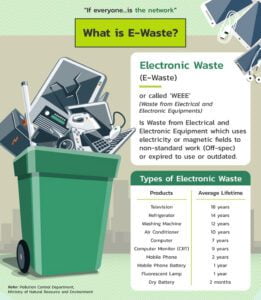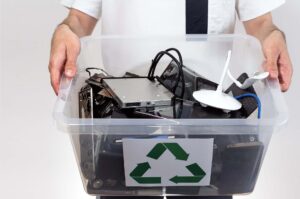Table of Contents
ToggleWhat kind of e waste produced in home?
- E-waste produced in homes comes from a variety of electronic devices, many of which are commonly used on a daily basis.
- Here’s a breakdown of the types of e-waste typically generated at home:
Small Household Electronics
- Mobile phones, tablets, and smartphones: Old, broken, or outdated phones and tablets.
- Laptops and desktops: Obsolete or non-functioning computers, monitors, and accessories.
- Printers and scanners: Older or non-working models of printers and scanners.
- Cameras and camcorders: Digital cameras, action cameras, and camcorders.
- Game consoles: Outdated gaming systems or accessories.
- External hard drives and USB drives: Broken or unused storage devices.
- MP3 players and portable media players: Obsolete devices like iPods, CD players, and Walkmans.
- Wearable tech: Old smartwatches, fitness trackers, or other personal electronics.

Large Household Appliances
- Televisions: Old CRT TVs or flat-screen models that are no longer functional or replaced.
- Refrigerators, washing machines, and dryers: Large appliances that have reached the end of their life.
- Air conditioners: Older models that are replaced or no longer in use.
Kitchen Appliances
- Microwaves: Broken or outdated microwave ovens.
- Blenders, toasters, and coffee makers: Small kitchen appliances that no longer work.
- Electric stoves and dishwashers: Appliances that are damaged or replaced.
4. Lighting Equipment
- LED, CFL, or fluorescent bulbs: Burnt-out or broken light bulbs, which may contain hazardous materials like mercury.
- Smart lighting systems: Smart bulbs, switches, and other lighting equipment that have stopped working.
5. Audio and Video Equipment
- Speakers and sound systems: Outdated or non-functional audio equipment.
- DVD/Blu-ray players: Devices that are no longer in use or replaced by streaming services.
- Projectors and home theater systems: Equipment that has become obsolete.
6. Networking and Communication Devices
- Wi-Fi routers and modems: Outdated or broken routers and modems.
- Cables and adapters: Old or damaged power cords, HDMI cables, USB cords, and charging cables.
- Landline phones and fax machines: Obsolete devices that have been replaced by mobile phones or internet-based communication.
7. Personal Care Devices
- Electric shavers, toothbrushes, and hairdryers: Personal care electronics that are no longer functional.
- Beauty gadgets: Devices like facial steamers, electric nail files, or hair straighteners.
8. Toys and Gadgets
- Electronic toys: Battery-operated or electronic toys that are broken or outdated.
- Drones: Small consumer drones that are no longer working or relevant.
9. Batteries and Chargers
- Rechargeable and non-rechargeable batteries: Dead or leaking batteries from remote controls, toys, and other electronics.
- Charging cables and adapters: Broken or obsolete power adapters and charging cables.
10. Smart Home Devices
- Smart thermostats, cameras, and doorbells: Outdated or non-functioning smart home devices.
- Security systems: Older electronic home security systems.
11. Miscellaneous
- Remote controls: Broken or obsolete remotes for TVs, air conditioners, and other appliances.
- Electric tools: Broken or outdated electric drills, saws, and other home tools.
- Compact discs (CDs) and DVDs: Discs that are no longer used or have been replaced by digital media.
Key Materials in Home E-Waste:
- Heavy metals: Lead, cadmium, and mercury in older electronics like CRT TVs and monitors.
- Plastics: Various plastic components in cases, cables, and accessories.
- Precious metals: Gold, silver, and copper found in circuit boards.
- Toxic chemicals: Some components contain hazardous materials like flame retardants and coolants.
Reducing, recycling, and disposing of this type of e-waste responsibly helps to minimize environmental impact and encourages sustainable consumption.

Methods to Reduce Electronic Waste in Home
- Reducing electronic waste (e-waste) at home requires thoughtful approaches that prioritize sustainability, reuse, and responsible disposal.
- Here are some effective strategies:

Repair and Upgrade Instead of Replace
- Repair broken electronics: Many devices can be fixed with simple repairs instead of being thrown away.
- Upgrade components: Upgrade parts such as RAM or storage in computers, rather than buying new devices.
Buy Quality, Long-Lasting Devices
- Choose durable products: Invest in high-quality electronics that last longer.
- Look for modular designs: Some companies offer modular electronics that allow easy repairs and upgrades.
Donate or Sell Old Devices
- Donate functional electronics: Charities or schools can often use older but functional devices.
- Sell used gadgets: Online platforms allow you to sell used electronics, which can extend their life.
Use Multi-Purpose Devices
- Consolidate electronics: For example, a single smartphone can replace the need for a separate camera, GPS, and music player, reducing the total number of devices.

Proper Recycling
- Recycle at e-waste centers: Many cities have dedicated e-waste recycling programs.
- Use manufacturer take-back programs: Some brands offer programs to take back old electronics for recycling.
Limit Unnecessary Purchases
- Avoid impulse buying of gadgets: Only purchase electronics that you truly need.
- Wait for technology upgrades: Buy new devices only when necessary, especially after major advancements.
Use Cloud Services and Digital Alternatives
- Digital media: Opt for cloud storage or streaming services instead of physical storage devices.
- Reduce paper use: Use digital apps for note-taking, calendars, and reminders to reduce the need for printers.
Extend Battery Life
- Optimize device settings: Reduce screen brightness, and close unnecessary apps to extend battery life.
- Proper battery care: Charge and store batteries correctly to avoid the need for early replacements.
Buy Energy-Efficient Electronics
- Energy Star-rated devices: Choose devices with high energy efficiency ratings to reduce electricity usage and environmental impact.
.

Best ways to reduce e-waste
- Reducing e-waste effectively involves adopting a mindset of sustainability and making responsible decisions throughout the lifecycle of electronic products.
- Here are the best ways to minimize e-waste:
Extend the Life of Electronics
- Repair when possible: Instead of replacing devices, repair them to extend their life. This can be done by fixing broken screens, replacing batteries, or upgrading components.
- Protect devices: Use cases, screen protectors, and other accessories to prevent damage.
- Regular maintenance: Clean and maintain devices to ensure they last longer.
Buy Sustainable and Durable Products
- Choose high-quality, long-lasting products: Durable electronics reduce the need for frequent replacements.
- Opt for sustainable brands: Many manufacturers now focus on producing eco-friendly devices with recyclable materials and offering take-back programs.
Recycle E-Waste Properly
- Use certified e-waste recyclers: Ensure that your old devices are recycled at certified facilities where materials are recovered and toxic components are handled safely.
- Check for local e-waste collection programs: Many communities offer e-waste recycling events or drop-off locations.
- Take advantage of manufacturer recycling programs: Some companies, like Apple and Samsung, offer trade-in or recycling options for their products.
Donate or Sell Functional Devices
- Donate to those in need: Functional but unused devices can be donated to schools, charities, or organizations that refurbish and distribute them.
- Sell used electronics: Platforms like eBay, Facebook Marketplace, or local classifieds allow you to sell used electronics, giving them a second life.
Opt for Refurbished or Pre-Owned Devices
- Buy refurbished products: Purchasing certified pre-owned or refurbished electronics reduces demand for new devices and lowers manufacturing waste.
- Trade-in old devices: Many companies offer trade-in options where you can exchange old devices for discounts on new ones, ensuring the old ones are refurbished or properly recycled.
Reduce Electronic Consumption
- Avoid unnecessary upgrades: Don’t buy new gadgets unless absolutely necessary. Wait for significant technological advancements before upgrading.
- Consolidate functions into one device: Use multi-functional devices like smartphones that combine the capabilities of cameras, GPS units, and music players.
Choose Devices with Modular Designs
- Opt for modular electronics: These allow you to easily replace or upgrade individual components, reducing the need to discard the entire device when only a part is broken.

Dispose of Batteries Properly
- Recycle rechargeable batteries: Many e-waste recyclers accept old batteries. Lithium-ion batteries, used in many electronics, can be hazardous if not disposed of properly.
- Use rechargeable batteries: Opt for rechargeable over disposable batteries to minimize waste.
Advocate for and Support E-Waste Legislation
- Support right-to-repair laws: These laws allow consumers to repair their own devices or take them to independent repair shops, promoting device longevity.
- Push for responsible manufacturing: Encourage brands to design for longevity, repairability, and recyclability.
Use Digital Solutions
- Adopt cloud services: Storing files in the cloud reduces the need for physical storage devices like USBs, DVDs, or hard drives.
- Use digital alternatives to physical gadgets: Digital note-taking apps, calendars, and e-books can replace physical devices, cutting down on the need for additional electronics.
Conclusion
- Implementing these practices can help significantly reduce electronic waste and promote a more sustainable household
- By following these strategies, we can make a significant impact on reducing e-waste and promoting a more sustainable approach to technology usage.
Post Views: 353
